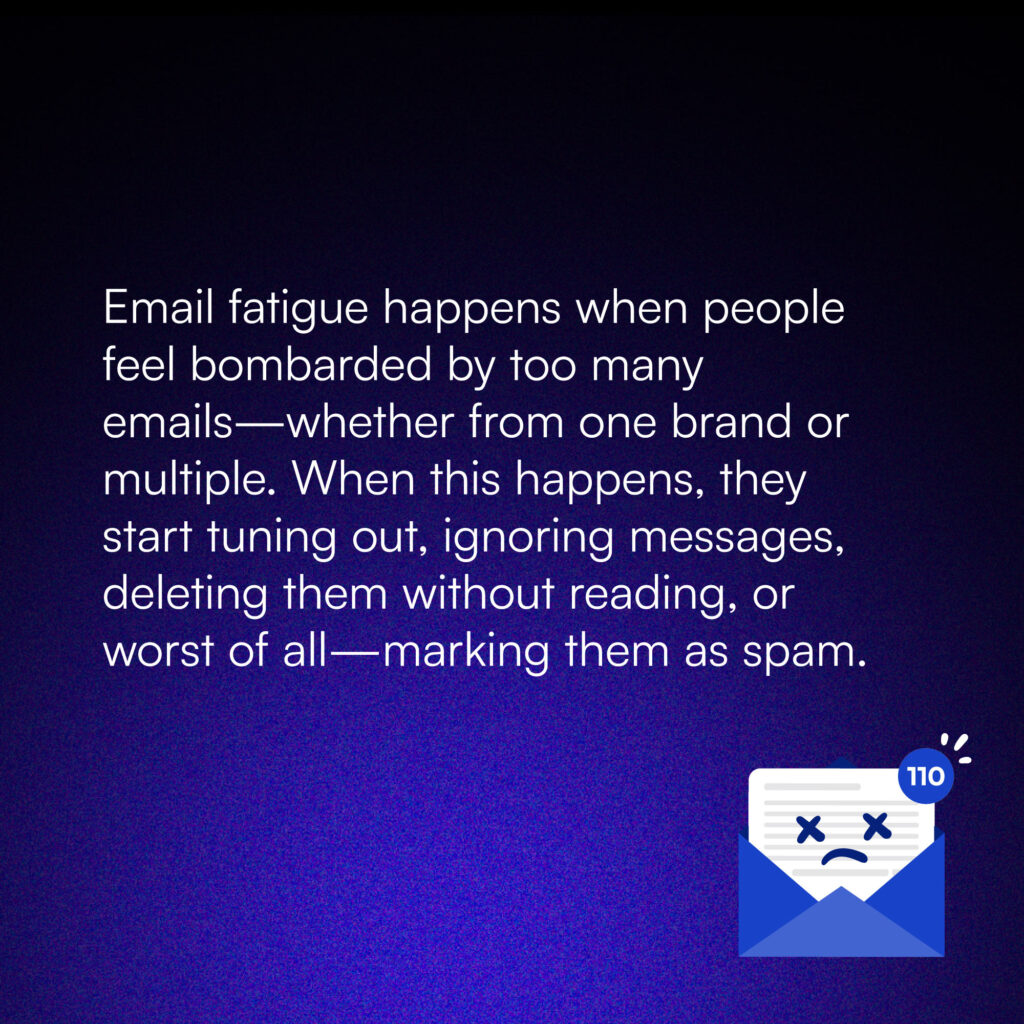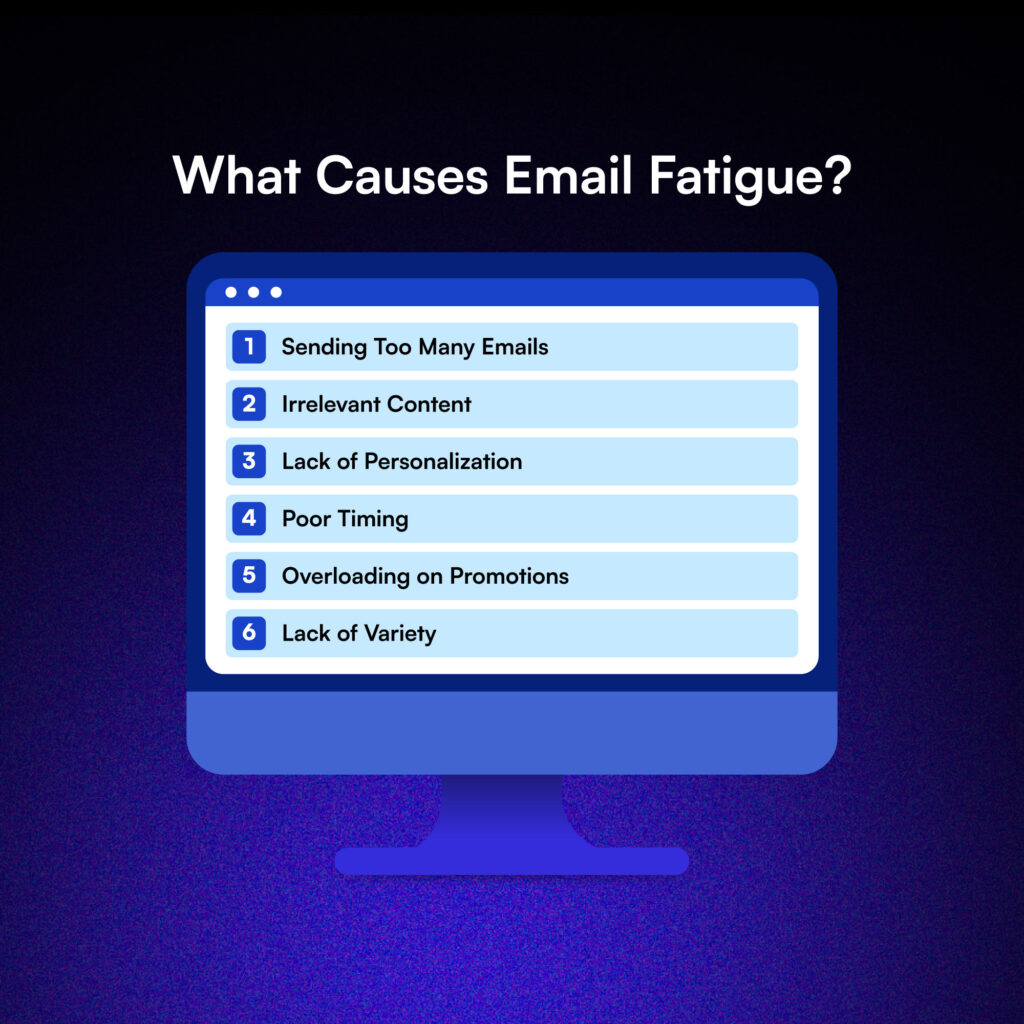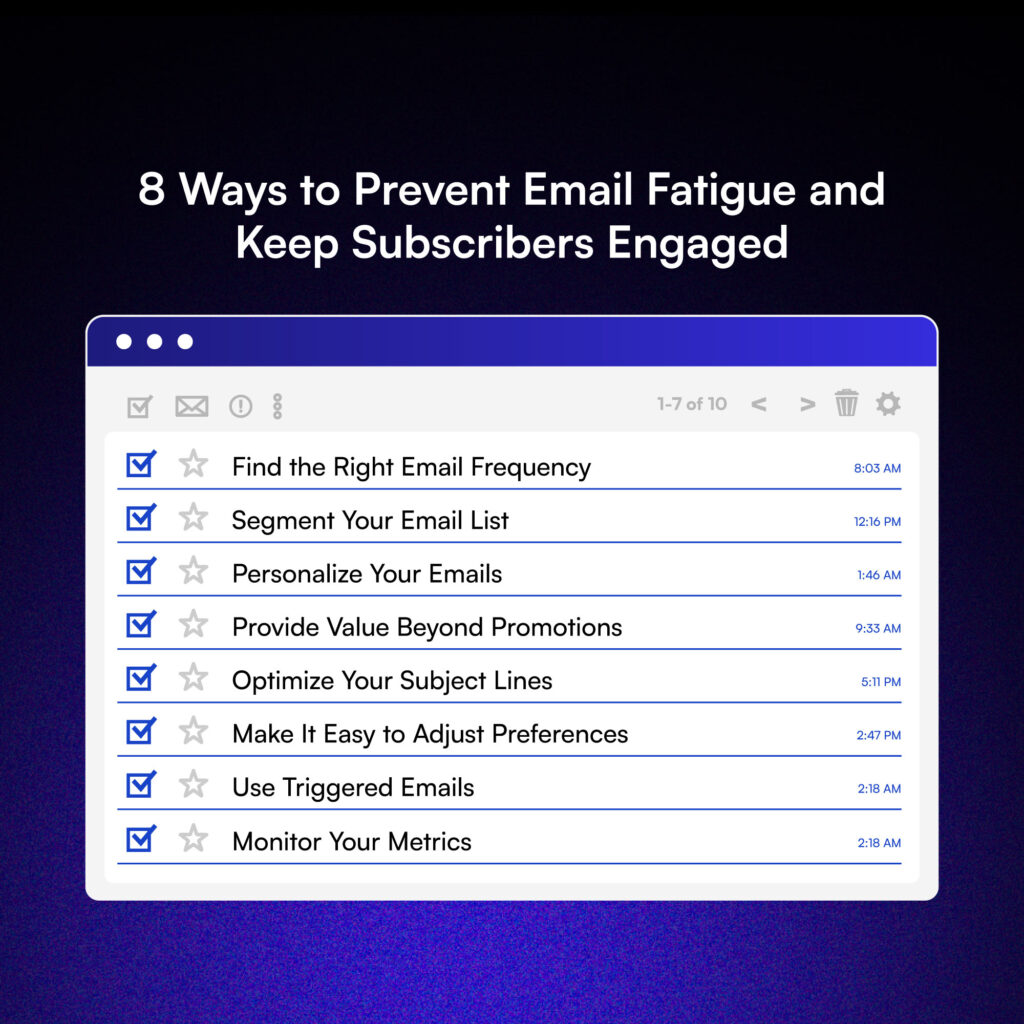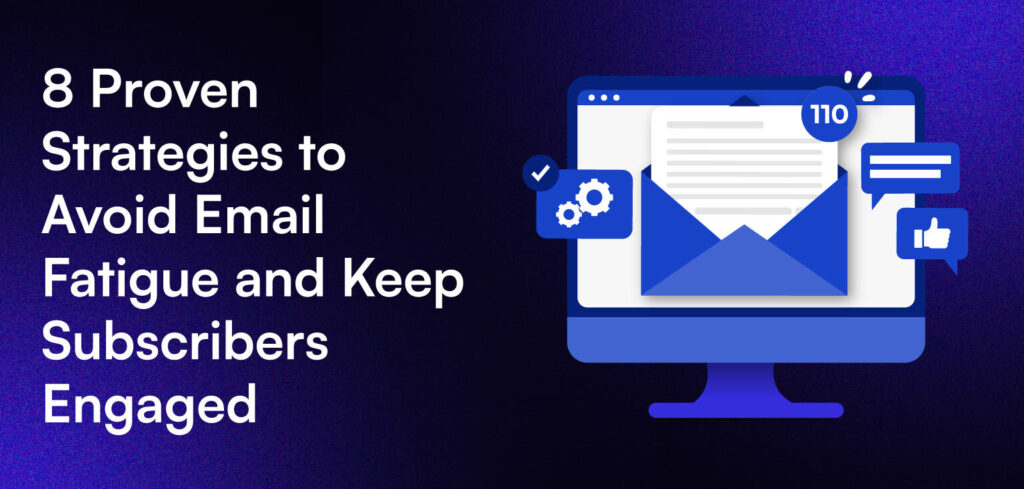Yes, email marketing is a game-changer for businesses, but let’s be honest—too many emails can backfire.
If your subscribers feel bombarded, they’ll start tuning you out, leading to lower open rates, fewer conversions, and a growing list of unsubscribes.
That’s email fatigue, and it’s a real threat to your marketing success.
So, how do you strike the right balance?
Let’s dive into what email fatigue is, why it happens, and how you can prevent it while keeping your audience engaged.
What Is Email Fatigue?
Ever feel like your inbox is bursting at the seams with marketing emails?
Your subscribers do too.

And here’s the kicker: even if your emails are well-crafted, too many of them can still push subscribers to disengage. If your emails start to feel like digital noise instead of valuable content, you risk losing your audience’s trust and attention.
But it’s not just about frequency. Relevance matters too.
If subscribers keep receiving emails that don’t align with their interests or needs, they’ll mentally (and sometimes literally) check out.
That’s why recognizing the signs of email fatigue early can help you adjust before it leads to major list decay.
Signs Your Subscribers Are Experiencing Email Fatigue
Not sure if your audience is losing interest? Watch out for these warning signs:
1. Declining Open Rates
If your open rates are dropping, that’s a clear indication that subscribers aren’t excited to see your emails in their inbox. Maybe they’ve started skipping over your messages, or worse, they’ve filtered them into a folder they never check.
This is an early warning sign that your emails might be too frequent, too predictable, or not relevant enough.
Pro tip: Try adjusting your sending frequency or testing new subject line styles to recapture attention.
2. Increasing Unsubscribe Rates
A small number of unsubscribes is normal. But if you notice a sudden spike, it’s a red flag. This usually means subscribers feel overwhelmed or no longer find value in your emails.
They might still like your brand, but they’re opting out because they feel like they’re being bombarded.
3. More Spam Complaints
If your emails start getting marked as spam, that’s a serious problem.
Not only does it damage your sender reputation, but it also raises the risk of your upcoming emails ending up in the spam folder. What’s concerning is that this can occur even with subscribers who genuinely wish to receive your emails.
Pro Tip:
A difficult unsubscribe process frustrates subscribers, making them more likely to mark your emails as spam just to make them stop. To prevent this, ensure your unsubscribe link is easy to find—ideally, one-click and visible in the email footer.
Also, consider adding a short exit survey to understand why they’re leaving. If they’re unsubscribing due to frequency or content preferences, you may be able to retain them with an option to adjust settings instead of opting out entirely.
4. Lower Click-Through and Conversion Rates
Even if people are still opening your emails, are they actually engaging with them? A drop in click-through rates means subscribers aren’t finding your content compelling enough to take action. If conversion rates are down too, it could indicate that your emails aren’t delivering the right message at the right time.
As best practice, test different content formats—like interactive emails, product recommendations, or exclusive offers, to keep subscribers engaged.
5. The Psychological Impact of Email Fatigue
Beyond the metrics, email fatigue has a real psychological impact on your audience. Too many emails can lead to:
- Cognitive overload – When people receive too much information, they struggle to process it and may tune out altogether.
- Decision fatigue – Bombarding subscribers with too many offers can make them less likely to take action.
- Negative brand perception – Annoyed subscribers may associate your brand with spam, reducing trust and credibility.
What Causes Email Fatigue?
Understanding why email fatigue happens is the first step toward preventing it. Here are some common culprits:

If you’re flooding inboxes, chances are your subscribers feel overwhelmed. Too many emails can lead to fatigue, higher unsubscribe rates, or even spam complaints.
Are your emails actually worth opening? If they feel generic, repetitive, or off-topic, subscribers will tune them out—or worse, unsubscribe.
3. Lack of Personalization
Nobody wants to feel like just another name on a list. If your emails don’t reflect subscriber preferences, past behavior, or interests, they’ll stop engaging.
4. Poor Timing
Even a great email can flop if sent at the wrong time. If you’re hitting inboxes in the middle of the night or too often, you risk annoying your audience.
5. Overloading on Promotions
If every email screams “buy now,” subscribers will stop paying attention. A healthy mix of educational, entertaining, and promotional content keeps engagement strong.
6. Lack of Variety
If your emails always look and sound the same, they’ll start to feel stale. Shake things up with videos, GIFs, quizzes, or interactive content to keep things fresh.
8 Ways to Prevent Email Fatigue and Keep Subscribers Engaged

Now that you know what causes email fatigue, let’s talk about solutions.
So, how do you keep your audience excited about your emails without overwhelming them?
The key is balance. You want to stay top-of-mind without making them feel like you’re constantly flooding their inbox.
Here’s how you can strike that perfect balance and keep subscribers engaged for the long haul.
1. Find the Right Email Frequency
So, how often should you send emails? That’s the million-dollar question.
But there’s no one-size-fits-all rule. It all depends on your audience and what keeps them engaged. Most brands see the sweet spot at 2-4 emails per week—enough to stay on your audience’s radar without overcrowding their inbox.
During big shopping events like Black Friday, Cyber Monday, and the holiday season, ramping up to 4-6 emails per week can work in your favor. With people actively looking for deals, more emails mean more chances to grab their attention.
Too few emails, and subscribers might forget about you. Too many, and they might get annoyed and unsubscribe.
The best approach? Test different sending frequencies and closely monitor your engagement metrics. Track open rates, click-through rates, and unsubscribe rates to find the optimal cadence for your audience.
2. Segment Your Email List
Not all subscribers are the same, so why treat them that way?
A new subscriber who just signed up might not want the same content as a loyal customer who’s been with you for years. That’s where segmentation comes in.
Segment your list based on:
- Demographics (age, location, gender)
- Behavior (purchase history, browsing activity, engagement level)
- Interests (specific products or services they’ve shown interest in)
- Email engagement (active vs. inactive subscribers)
By sending tailored content to each segment, you increase the chances of engagement. In fact, a report shows that segmented email campaigns drive a staggering 760% increase in revenue.
3. Personalize Your Emails
Personalization goes beyond just adding a first name to your subject line. Today’s consumers expect a more tailored experience. Use dynamic content to make emails feel like they were crafted just for them.
Examples of personalization:
- Product recommendations based on browsing history or past purchases
- Birthday or anniversary discounts to add a personal touch
- Behavior-triggered emails (e.g., a follow-up email after a cart abandonment)
4. Provide Value Beyond Promotions
Nobody wants to feel like they’re being sold to all the time.
If every email you send is a sales pitch, subscribers will tune out. Instead, mix in valuable content that educates, entertains, or informs. When subscribers see that your emails offer value beyond just discounts, they’ll be more likely to open them—and stick around.
Ideas for non-promotional content:
- Educational content: How-to guides, tutorials, and case studies
- Industry insights: Market trends, expert tips, and reports
- Exclusive content: Behind-the-scenes stories, VIP access, and early product launches
5. Optimize Your Subject Lines
Your subject line is the first impression your email makes, and it can make or break your open rates. A dull or spammy subject line? Straight to the trash. A compelling and intriguing one? Opened in a heartbeat.
Best practices for subject lines:
- Keep it short and to the point (Aim for 6-8 words)
- Create curiosity (e.g., “You’re missing out on this secret!”)
- Personalize when possible (e.g., “John, your exclusive offer is inside”)
- A/B test different versions to see what resonates most
6. Make It Easy to Adjust Preferences
Instead of forcing subscribers to choose between receiving all your emails or unsubscribing entirely, give them control over how often they hear from you.
Set up an email preference center where they can choose their preferred frequency.
For example, they could opt for:
- Daily, weekly, or monthly emails
- Only emails about sales and promotions
- Only educational content or newsletters
This helps reduce email fatigue while keeping them engaged on their terms. It also provides valuable insights into what content resonates most with your audience.
7. Use Triggered Emails
One of the best ways to keep engagement high is by sending emails that are triggered by a subscriber’s actions. Unlike mass email blasts, triggered emails feel more natural and relevant because they’re based on real-time behaviors.
Examples of triggered emails:
- Welcome emails when someone signs up
- Abandoned cart reminders to nudge shoppers toward completing a purchase
- Post-purchase follow-ups to encourage reviews or upsells
8. Monitor Your Metrics
Even the best email strategy needs regular fine-tuning. Keep an eye on your key metrics to spot trends and make data-driven decisions.
Key metrics to track:
- Open rates (Are people opening your emails?)
- Click-through rates (Are they engaging with your content?)
- Unsubscribes (Are you sending too many emails?)
- Spam complaints (Are your emails being marked as spam?)
If you notice a drop in engagement, take action quickly. Test different subject lines, tweak your frequency, or refresh your content to re-engage your audience.
Keep Your Emails Fresh and Valuable
Email fatigue is real, but with the right strategy, you can keep subscribers engaged without overwhelming them.
Quality beats quantity every time.
Personalize your messages, segment your list, and let subscribers control their preferences.
By following these strategies, you’ll not only prevent email fatigue but also build stronger, long-lasting relationships with your audience. And that’s the real goal of email marketing.


